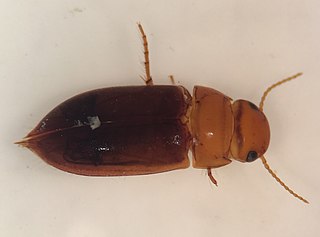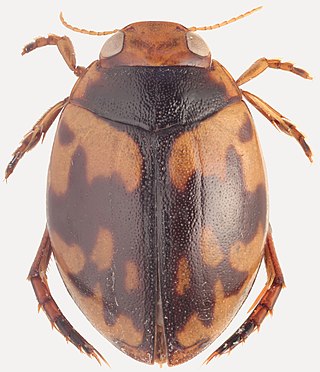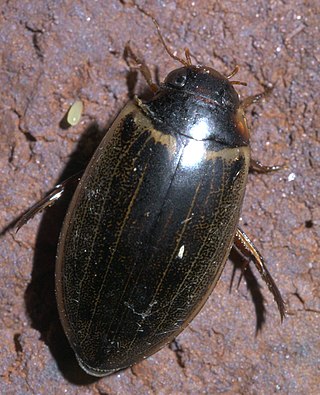
The Dytiscidae – based on the Greek dytikos (δυτικός), "able to dive" – are the predaceous diving beetles, a family of water beetles. They occur in virtually any freshwater habitat around the world, but a few species live among leaf litter. The adults of most are between 1 and 2.5 cm (0.4–1.0 in) long, though much variation is seen between species. The European Dytiscus latissimus and Brazilian Megadytes ducalis are the largest, reaching up to 4.5 cm (1.8 in) and 4.75 cm (1.9 in) respectively. In contrast, the smallest is likely the Australian Limbodessus atypicali of subterranean waters, which only is about 0.9 mm (0.035 in) long. Most are dark brown, blackish, or dark olive in color with golden highlights in some subfamilies. The larvae are commonly known as water tigers due to their voracious appetite. They have short, but sharp mandibles and immediately upon biting, they deliver digestive enzymes into prey to suck their liquefied remains. The family includes more than 4,000 described species in numerous genera.

Graphoderus is a genus of beetle in family Dytiscidae native to the Holarctic.

Megadytes is a genus of diving beetles in the family Dytiscidae. They are found in slow-moving or static freshwater habitats throughout most of the Neotropics, ranging from Florida and Mexico, through the West Indies and Central America, to South America as far south as central Argentina. The adult beetles measure about 1.65–4.75 cm (0.6–1.9 in) long depending on the exact species and the largest is also the largest in the family.

Thermonectus is a genus of beetle in family Dytiscidae. This genus is native to the New World, and mainly from warm temperate to tropical in distribution, but one species, T. basillaris occurs as far north as southern Ontario, Canada. They inhabit a wide range of freshwater habitats with static water and are often common. They are generally about 0.8–1.5 cm (0.3–0.6 in) long and a few species from desert pools in North America have a distinct yellow-spotted pattern on a black background.

Cybister, is a genus of beetle in family Dytiscidae. They are found in much of the world, including all continents except Antarctica. As of 2021 there are 96 species and 9 additional subspecies among four subgenera in the genus.

Sandracottus is a genus of beetles in the family Dytiscidae. These aquatic beetles are found in ponds and slow streams from South Asia east to southern Japan, and south to Australia. They are generally about 1–1.5 cm (0.4–0.6 in) long and often have distinctive markings.
Spencerhydrus is a genus of beetles in the family Dytiscidae. The genus is found only in southern Australia and contains the following two species:

Huxelhydrus is a genus of predaceous diving beetles in the family Dytiscidae. This genus has a single species, Huxelhydrus syntheticus, found in New Zealand.

Hydroglyphus is a genus of predaceous diving beetles in the family Dytiscidae. There are more than 90 described species in Hydroglyphus, found in Africa, Australasia, Indomalaya, and the Palearctic.
Andex is a genus of predaceous diving beetles in the family Dytiscidae. This genus has a single species, Andex insignis.
Coelhydrus is a genus of predaceous diving beetles in the family Dytiscidae. This genus has a single species, Coelhydrus brevicollis. It is found in South Africa.
Darwinhydrus is a genus of predaceous diving beetles in the family Dytiscidae. This genus has a single species, Darwinhydrus solidus, found in South Africa.
Primospes is a genus of predaceous diving beetles in the family Dytiscidae. This genus has a single species, Primospes suturalis, found in Africa.

Celina is a genus of predaceous diving beetles in the family Dytiscidae. There are at least 30 described species in Celina.
Exocelina subjecta is a species of diving beetle in the genus Exocelina of the subfamily Copelatinae in the family Dytiscidae, described by David Sharp in 1882.

Hyphydrini is a tribe of predaceous diving beetles in the family Dytiscidae. There are about 16 genera and more than 390 described species in Hyphydrini.

Laccophilus pictus is a species of predaceous diving beetle in the family Dytiscidae. It is found in the Neotropics.
Laccophilus oscillator is a species of predaceous diving beetle in the family Dytiscidae. It is found in North America and the Neotropics.

Meridiorhantus is a genus of predaceous diving beetles in the family Dytiscidae. There are about five described species in Meridiorhantus, found in the Neotropics and North America. These species were formerly members of the genus Rhantus, but were moved to Meridiorhantus when it was created by Balke et al. in 2017.
Hydrovatus subtilis, is a species of predaceous diving beetle found in India, Andaman & Nicobar Islands, Sri Lanka, Indonesia, Japan, Laos, Malaysia, and Thailand.











